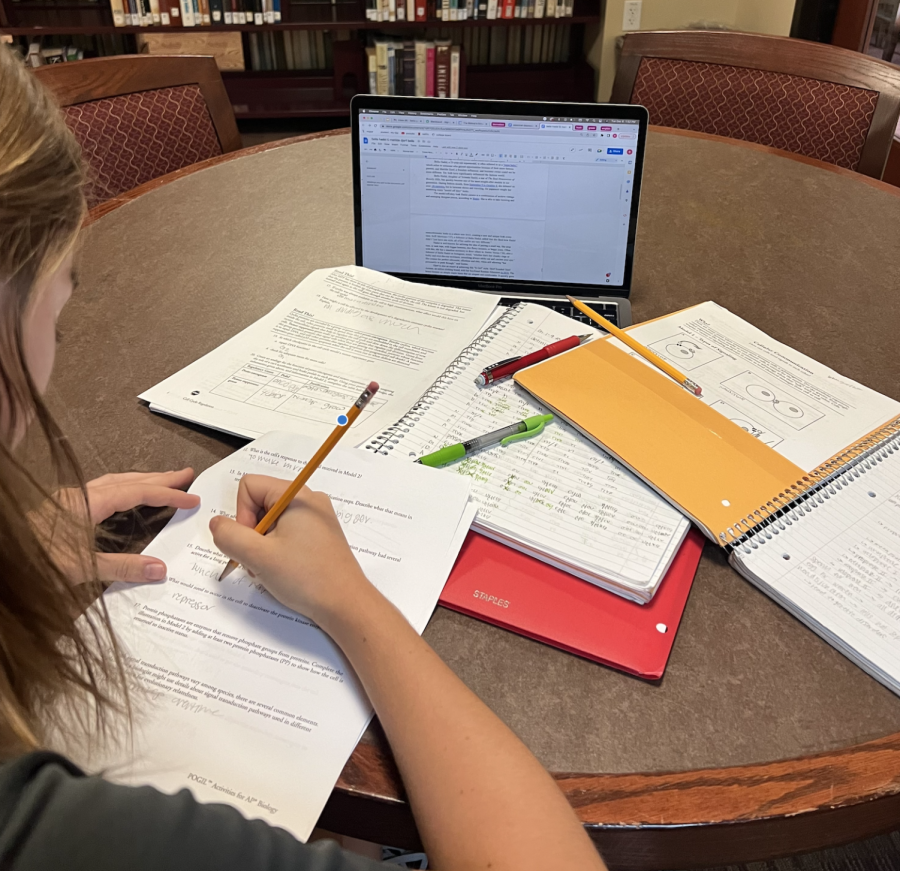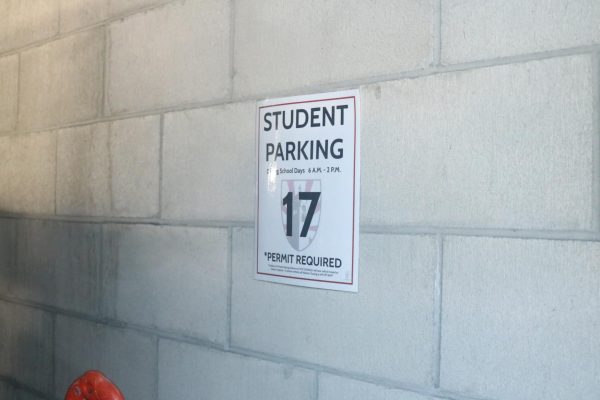Winter Blues with Assignments Due
How can we maintain a balance of school and mental health with shorter days and colder nights?
Lily Gover (‘24) works endlessly on her piles of homework. Stress only seems to build, and the days only are getting shorter and darker. This can only lead to one thing: how can we prevent that?
Mariah Carey defrosting, drinking warm hot chocolate, giving gifts to the ones we love, and feeling grateful we do not live somewhere where it snows, are some of the many experiences commonly shared during the fall and winter months. However, the seasons typically associated with joy and love also bring cumulative tests, college applications, all-nighters, loads of stress, and darkness at 5:00 p.m.
About 5% of the US population, most commonly women, experience seasonal affective disorder (SAD). Around 10 to 20% of the United States population, according to the Cleveland Clinic, experience milder levels of what is often described as winter blues.
Seasonal depression (or SAD) is exactly what it sounds like: symptoms of depression that are more prevalent during certain seasons of the year, specifically fall. With the added stress of the workload especially during the fall and winter months at Bishop’s, how can we find a sustainable balance during the dark, exhausting, final weeks of December?
According to Kelly Rohan, a professor of psychological science and a clinical psychologist at the University of Vermont, in an interview for the New York Times, seasonal affective disorder is often triggered by the short, dark days that winter brings. Our body has a biological clock, so we produce melatonin, a natural hormone, to prompt sleep at night. In the morning, production begins to decrease, allowing our bodies to wake up. With the change in the amount of daylight, the production of melatonin will last well into the morning, leaving one feeling fatigued, and then start much later in the night, eventually creating a cycle of tiredness.
Not only do the shorter days affect many people’s biological clocks, but the sheer lack of sunshine also contributes to a lack of serotonin. Serotonin can be regulated by the sun, or vitamin D according to the Cleveland Clinic. The Public Broadcasting System, North Carolina, (PBSNC), reported from the National Library of Medicine that sunlight stimulates the production of serotonin.
Ms. Lauren Gray, a School counselor, affirmed this fact and added that the loss of vitamin D during daylight savings can seriously affect one’s mood. Grace Dempsey (‘26) shared that the lack of sunlight early in the day “puts [her] in a bad mood,” because it’s “hard to do anything after school is over.”
People may experience symptoms of SAD, such as low energy, lack of motivation, trouble concentrating, anxiety, and oversleeping, according to Mayo Clinic. The bustling school life that many Bishop’s students experience, the combination of shorter days, and semester grades on the horizon may lead to feelings of stress.
Ms. Gray said that at Bishop’s, this combination can lead to students experiencing a “lack of motivation.” Director of Counseling Ms. Megan Broderick added that those feelings “will really enhance your inability to do what you need to do to take care of yourself,” and added that eventually, “it just becomes an increasing cycle.”
This cycle of stress, constant work, and poor sleep is not only unsustainable, but it only adds to the idea that taking a break from schoolwork seems nearly impossible. There seems to be that split second of rest during Thanksgiving break, but after that, it is back to battling a constant workload.
Ms. Broderick emphasized, “It is the season of stress and the season of rest,” a phrase coined by History and Social Sciences teacher Ms. Emily Smith. Ms. Broderick added, “For some students who don’t experience [winter blues or SAD], normally it can be a really really trying time, and, again, we lose those coping mechanisms, and we start staying up too late, eating unhealthy, and isolating ourselves.”
Both counselors understood that many students feel like there is not enough time to take a break. Grace Dabir (‘24), expressed that she often “feels extremely stressed,” during this time, and juniors Kylie Larson and Emi Ayala-Sekiguchi nodded their heads in agreement. To that sentiment, Ms. Gray and Broderick proposed many solutions that some might find useful.
Ms. Gray expressed that thinking creatively about how one takes a break would be more effective and realistic than taking an entire afternoon off. She said, “Maybe it is doing something like taking 10 minutes to walk around the block and listen[ing] to three songs that will lift you up.” Getting outside is extremely important if you are experiencing any symptoms of SAD. Cleveland Clinic noted that getting outside a little each day, and exercising could relieve stress and anxiety.
Ms. Gray and Ms. Broderick also highlighted the importance of self-talk, and internal dialogue. “So instead of saying, ‘why am I so overwhelmed, while everyone else at Bishop’s is doing X, Y, and Z, and no one else is having this hard time,’” Ms. Gray recommended coming up with a mantra to challenge this feeling of invalidation.
Your feeling of stress is valid; it is the end of the semester and cumulatives will be hard. Ms. Broderick added, “Show yourself a little grace.”
As the days get shorter, and cumulative tests grow nearer make sure to take a moment for yourself, even if it is just a few minutes. Right now is a stressful time, and that is okay. Winter break is just around the corner.

Bella Gallus is a senior and the Managing Editor for The Tower. Bella relies on her Spotify playlists, carefully curated for each of her moods, and her...






